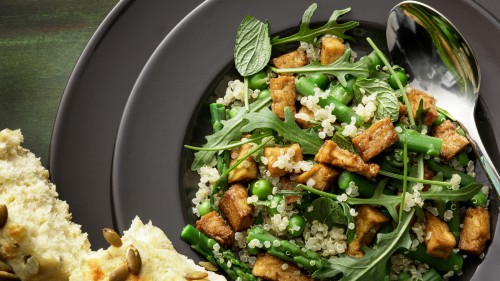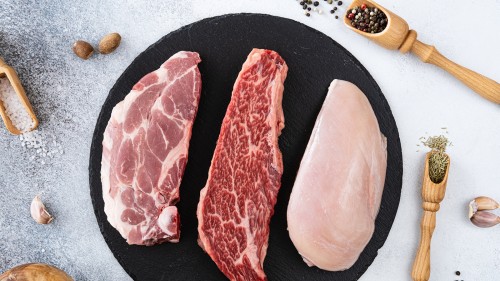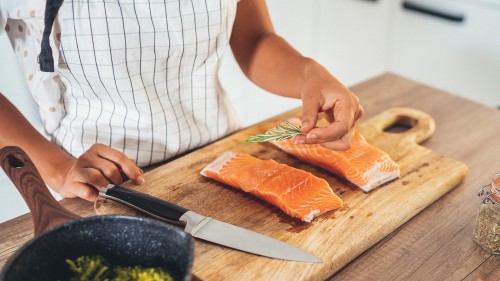9 Nutritious Protein-Rich Foods That Provide Extra Nutrients
Published on February 23, 2022
Medically Reviewed by Ana Reisdorf, MS, RD
Protein is a well-known macronutrient we need every day. But what are the best high-protein foods out there? Our dietitian shares her favorite whole food sources, which offer more than just protein.


When we think of protein in our bodies, we often think of muscle building.
While it’s true that protein is needed for gaining strength and tone, protein is used in every cell of the body, from our hair follicles to our toenails.
We use protein for countless functions in the body. Every day our bodies make new cells and repair injured tissues. (1)
While protein deficiency is rare in the United States, if we don’t get enough of it, our bodies will break down existing muscles to use the amino acids in more essential places.
For example, if our heart muscle needs to make new cells and we haven’t been eating enough protein, our body can take it from those quadricep muscles you’ve been working on.
Even inactive people need dietary protein for good health. Current recommendations for healthy people are 0.8–1.6 grams or more of protein per kilogram of body weight each day, depending on their activity level. (2)
This means a person who weighs 150 pounds (or 68 kilograms) should eat 54–136 grams of protein each day.
While many foods are high in protein, some plant-based choices need to be paired with other foods to make them “high quality” or “complete” proteins.
What is a high-quality protein? It is a food source with all of the essential amino acids humans need to build new molecules and stay healthy.
It’s also a bonus when protein sources provide extra nutrients in addition to the protein itself. That way, you get more nutritional value for your body and your pocketbook.
Here are 9 protein sources that offer more for your muscles and beyond.
1. Eggs
One egg provides over 6 grams of protein in its small elliptical package, along with many other nutrients.
These little ovals have been the subject of cholesterol controversy for decades. However, the American Heart Association is no longer firmly against eating eggs, especially since at least one study has shown that moderate intake may fight against heart disease. (3, 4, 5)
In addition to being packed with protein, an egg provides 27% of the recommended intake for choline. (6)
Choline helps build cell membranes. It’s also a building block for acetylcholine, a neurotransmitter that helps the brain and nervous system with memory, mood, and muscle control.
Some science shows that there may be a link between choline and cognitive function. One study of 1,391 people showed that people who had higher choline intakes performed better in memory and learning tests. (7)
Eggs may also be good for eye health. One study showed that eating eggs once a day increased the participants’ lutein and zeaxanthin, two carotenoids found in eyes that are linked to visual health. (8)
For even more nutritional value, look for eggs that advertise more omega-3 fatty acid on the carton. Most Americans struggle to get enough of this healthy fat. (9)
The chickens who produce these eggs are fed a special diet high in omega-3s, which they transfer to their eggs. (10)
Summary
Eggs are a valuable protein source with vitamins and macronutrients that will nourish your whole body, including your brain and eyes.
2. Legumes: Beans, Peas, and Lentils
Whether you’re a vegan or omnivore, beans, peas, and lentils are powerful sources of protein. Just one cup of legumes can provide 14–18 grams.
But protein is only the beginning. Legumes are high-protein, low-calorie foods. This means they’re great for weight loss if that’s your goal.
For an excellent source of vegan iron, you may want to try some lentil soup.
Iron is an important component of hemoglobin, a molecule in red blood cells responsible for the delivery of oxygen to every organ in the body, including the brain. (11)
Hummus anyone? Just 1/2 cup of chickpeas, also known as garbanzo beans, provide a good source of folate, a nutrient needed to make DNA in our bodies. (12)
Folate is also important for women who could become pregnant, to help avoid neural tube defects in their infants.
Chickpeas, like many legumes, are also an excellent source of manganese. This nutrient helps the body maintain a healthy immune system, boosts energy levels, and protects cells from damage. (13)
All legumes are loaded with fiber, which is needed for a healthy digestive system. (14)
The soluble fiber found in legumes can help keep cholesterol levels within normal ranges. Navy beans are a rich source of fiber, with just 1 cup providing 19 grams. (15)
Legumes do lack the amino acid methionine, but it’s an easy fix. Simply pairing legumes with a whole grain like brown rice or wheat crackers will complete its amino acid makeup. (16)
Summary
Legumes are high-protein, low-fat foods that are packed with other nutrients. Eat a wide variety of legumes and pair them with whole grains to gain the most nutritional value.
3. Kefir
Want a source of 9 grams of protein that also improves your digestive and immune systems? Try drinking a cup of kefir, the probiotic-containing food consumed by humans for centuries.
Kefir is made by fermenting milk with beneficial bacteria or kefir “grains.”
Kefir sometimes contains over 50 different bacteria and yeasts, including several strains of Lactobacillus, some of which have been studied for health benefits. (17)
A review of research on kefir summarized how the microbes in kefir can fight harmful bacteria strains like E. coli, Salmonella, and Staphylococcus aureus, microbes that can lead to foodborne illnesses. (17)
The research also pointed to studies that showed kefir’s anti-inflammatory and immune-boosting effects.
Another research review in 2020 showed that antiviral and anti-inflammatory properties in kefir may possibly protect COVID-19 patients from the most devastating effects of the virus, including death. (18)
Summary
In addition to being a high-quality source of protein, kefir is a probiotic food that may offer several health benefits, including fighting against COVID-19.
4. Sockeye Salmon and Trout
Fish is often recommended as a healthy source of protein, and for good reason. A 3 oz serving of salmon or trout packs over 22 grams of protein and so much more.
Most people know that fatty fish is a valuable source of healthy polyunsaturated fatty acid, including omega-3. But what about that elusive nutrient that’s hard to find in food, vitamin D?
Vitamin D is a nutrient we need for calcium absorption and strong bones. (19)
It’s also important for a healthy immune system. Some research shows that people with lower vitamin D stores may have more severe cases of COVID-19 if exposed than those with adequate stores. (20)
Humans are meant to make vitamin D by our skin’s exposure to sunlight, but it’s hard to do in today’s world.
Our lifestyles often keep us indoors and out of the sun on most days, and when we do get outside, we often block the sun’s rays with clothing and sunblock to avoid cancer and skin damage.
It’s rare to find vitamin D naturally occurring in food. However, salmon and trout are significant sources of vitamin D that can help make up for the sun-exposure deficit.
A serving the size of a deck of cards provides about 16 micrograms, or 80% of what you need in a day.
Summary
One serving of fatty fish like salmon and trout contains 22 grams of protein and is an excellent source of vitamin D, a nutrient that is hard to find in food.
5. Soybeans
Yes, soybeans are legumes, which were mentioned above. But the popular bright green bean deserves special attention.
First, soybeans are a complete source of vegan protein. One cup of whole soybeans contains 18 grams of protein. (21)
Soybeans also contain a high amount of a nutrient called isoflavones, a molecule that acts a bit like estrogen in the body. (22)
Studies show that these isoflavones may have benefits, including helping postmenopausal women with fighting hot flashes and osteoporosis. (23)
Soybeans are also a versatile food found in many forms at the local grocery store. These forms include whole beans called edamame, soy beverage, condensed soy beverage called tofu, and fermented probiotic soy paste called miso.
Summary
Soybeans are a versatile, high-quality source of protein. They contain other nutrients, including isoflavones, which may offer relief from postmenopausal symptoms.
6. Lean Poultry
Animal protein sources, including chicken breast and turkey, are known for being high-quality or complete proteins.
This means they contain all the essential amino acids the human body needs. A 3-ounce serving of chicken breast, for example, holds 26 grams of protein.
If you’re having trouble with mood or sleep, you might try adding more poultry to your diet.
Tryptophan is one of the essential amino acids that is especially high in turkey. Tryptophan is necessary for making both melatonin and serotonin, two molecules that regulate mood and sleep in the body. (24)
Chicken is a good source of magnesium.
Magnesium is important for muscle building and making new proteins in the body. It also helps with muscle function, transporting calcium and potassium across muscle cell membranes. (25)
Poultry is also high in vitamin B6. This vitamin is important for metabolizing food into energy. (26)
Summary
Poultry is a solid source of 26 grams of high-quality protein. Eating poultry protein has the added benefits of magnesium, high amounts of tryptophan, and vitamin B6.
7. Nuts and Nut Butters
Nuts offer the convenience of being portable. Unlike many other proteins which spoil easily, nuts don’t require refrigeration and can be thrown in a backpack for that long trail run.
And one ounce of nuts contains about 6 grams of protein.
Walnuts are a good source of omega-3 fatty acids. Omega-3s are important for cell membranes and for many functions of the brain, heart, and endocrine system. (27)
Just one ounce of almonds contains about half of your daily supply of vitamin E. This nutrient is an antioxidant that helps protect cells. (28)
Vitamin E is also important to the immune system and helps widen blood vessels, which improves blood flow and prevents unwanted blood clotting.
Although nuts and seeds are not complete sources of protein, pairing them with a whole grain to make them complete is easy to do. Try sprinkling walnuts in your oatmeal or spreading almond butter on your whole-wheat toast.
Summary
Along with offering 6 grams of vegan protein per serving, some nuts provide a source of omega-3 fatty acids and vitamin E.
8. Pumpkin and Sunflower Seeds
Along with providing 5–7 grams of protein in a 1-ounce serving, pumpkin and sunflower seeds offer minerals, including zinc and copper.
Zinc is important for a properly functioning immune system. It’s also important for making new proteins in the body and healing wounds. Eating zinc regularly is important because humans don’t have a way to store it in the body. (29)
Copper isn’t just a valuable metal. It’s important for human nutrition and used for brain development and immune function. (30)
While copper deficiency is rare in the United States, some people, like those with celiac disease, are at higher risk.
Sunflower seeds are especially high in copper. One ounce provides over half of what is needed for the day. (31)
Summary
Pumpkin and sunflower seeds offer both protein and important minerals we need every day.
9. Lean Beef
You read that right. Red meat is on the list of top proteins.
While red meat is not essential to a healthy diet, it is undoubtedly a solid source of high-quality protein that comes packaged with other nutrients we need.
Vitamin B12 is important for making DNA and preventing megaloblastic anemia, which makes sufferers feel weak. One 3-ounce serving of lean beef offers 100% of the daily need for vitamin B12. (32)
People who suffer from iron-deficiency anemia may benefit from eating lean beef. When it comes to iron, food sources have two kinds: (33, 34)
- Nonheme – found in plant and animal sources.
- Heme – found only in animal products like meat, fish, and poultry.
Heme iron absorbs into the body better than nonheme.
Lean beef is one of the highest sources of heme iron. A 4-ounce serving of lean beef provides over 2 mg.
To increase iron absorption even more, pair it with foods high in vitamin C. Consider meals like broccoli with beef, or put tomatoes in your beef and bean chili.
Summary
Beef is a complete source of protein that also provides vitamin B12 and heme iron.
Sample One-Day Meal Plan
So how would a person get the protein they need for the day? While it may seem like each food recommended only has small amounts of protein, it adds up quickly over the day.
| Breakfast | |
| 1 scrambled egg with spinach | 6 grams |
| 1/2 cup oats cooked in 1 cup soy beverage | 7 grams |
| 1 oz walnuts plus apple slices | 6 grams |
| Snack | |
| 2 tablespoons peanut butter with 1 apple | 7 grams |
| Lunch | |
| 3 oz chicken sandwich with salad | 26 grams |
| Snack | |
| 1/2 cup hummus with whole-grain crackers | 7 grams |
| Dinner | |
| 3 oz baked salmon | 18 grams |
| 1 cup lentil and brown rice soup | 18 grams |
| Total Protein for the Day | 95 grams |
At the beginning of the article, we calculated that a healthy, 150-lb person would need 54–136 grams of protein in a day, depending on their activity level.
A sample meal plan like this would provide the person with much more than the minimum recommendation, plus many more nutrients!
Frequently Asked Questions
Can I get enough protein if I choose a vegetarian or vegan diet plan?
Yes, even athletes who are very physically active can get enough protein on a vegan diet.
Protein sources from plants like those suggested in this article can be paired with whole grains like brown rice or whole-wheat crackers to make proteins complete or high in quality.
Are animal sources of protein bad for you?
Not necessarily. Animal protein can be a healthy part of a plant-based diet. The key is to practice moderation and try to choose sources that are not high in saturated fats.
Animal protein sources can offer nutrients that are harder to get from vegetable protein sources. For example, fatty fish like sardines are an excellent source of the right balance of omega-3 fatty acids.
And B12 is abundant in meat, fish, and poultry, but almost absent in plant foods.
Do fruit and vegetables contain protein?
Some vegetables and fruit contain a significant amount of protein. For example, broccoli, Brussels sprouts, and asparagus all contain over 4 grams per one-cup serving.
Fruit generally has less protein than vegetables. However, there are some exceptions, a cup of jackfruit has almost 3 grams of protein, and a cup of guava has over four grams.
Other plant foods like legumes, nuts, and seeds are very high in protein. Grains like corn and wheat also contain moderate amounts.
The Bottom Line
While getting enough protein is important for daily health, it’s best to go for sources that offer other nutrients as well.
By aiming for variety and nutrient density, you’re going to find more value in every bite you eat and every dollar you spend at the grocery store.
High-quality protein can be consumed from both animal and plant sources. Some plant proteins may require a small amount of planning by pairing with grains to make them complete.
At WellnessVerge, we only use reputable sources, including peer-reviewed medical journals and well-respected academic institutions.
- Protein:
https://www.ncbi.nlm.nih.gov/pmc/articles/PMC6140426/ - Dietary protein intake and human health:
https://pubs.rsc.org/en/content/articlelanding/2016/FO/C5FO01530H - Eggs: good or bad?:
https://www.cambridge.org/core/journals/proceedings-of-the-nutrition-society/article/eggs-good-or-bad/48F64CD2DD8FE97F78922E2FD0C60C2D - Are eggs good for you or not?:
https://www.heart.org/en/news/2018/08/15/are-eggs-good-for-you-or-not - Associations of egg consumption with cardiovascular disease in a cohort study of 0.5 million Chinese adults:
https://heart.bmj.com/content/104/21/1756 - Choline:
https://ods.od.nih.gov/factsheets/Choline-HealthProfessional/ - The relation of dietary choline to cognitive performance and white-matter hyperintensity in the Framingham Offspring Cohort:
https://pubmed.ncbi.nlm.nih.gov/22071706/ - Consumption of One Egg Per Day Increases Serum Lutein and Zeaxanthin Concentrations in Older Adults without Altering Serum Lipid and Lipoprotein Cholesterol Concentrations:
https://academic.oup.com/jn/article/136/10/2519/4746690 - U.S. adults are not meeting recommended levels for fish and omega-3 fatty acid intake: results of an analysis using observational data from NHANES 2003–2008:
https://www.ncbi.nlm.nih.gov/pmc/articles/PMC3992162/ - Comparative omega-3 fatty acid enrichment of egg yolks from first-cycle laying hens fed flaxseed oil or ground flaxseed:
https://www.ncbi.nlm.nih.gov/pmc/articles/PMC6280955/ - Iron:
https://ods.od.nih.gov/factsheets/Iron-HealthProfessional/ - Folate:
https://ods.od.nih.gov/factsheets/Folate-HealthProfessional/ - Manganese:
https://ods.od.nih.gov/factsheets/Manganese-Consumer/ - Dietary Fiber:
https://www.ncbi.nlm.nih.gov/books/NBK218764/ - FoodData Central: Beans, navy, mature seeds, cooked, boiled, with salt:
https://fdc.nal.usda.gov/fdc-app.html#/food-details/173794/nutrients - Foods for Plant-Based Diets: Challenges and Innovations:
https://www.ncbi.nlm.nih.gov/pmc/articles/PMC7912826/ - Microbiological, technological and therapeutic properties of kefir: a natural probiotic beverage:
https://www.ncbi.nlm.nih.gov/pmc/articles/PMC3833126/ - Kefir: A protective dietary supplementation against viral infection:
https://www.ncbi.nlm.nih.gov/pmc/articles/PMC7655491/ - Vitamin D:
https://ods.od.nih.gov/factsheets/VitaminD-Consumer/ - Dietary Supplements in the Time of COVID-19:
https://ods.od.nih.gov/factsheets/DietarySupplementsInTheTimeOfCOVID19-Consumer/ - FoodData Central: Edamame, frozen, prepared:
https://fdc.nal.usda.gov/fdc-app.html#/food-details/168411/nutrients - Isoflavones:
https://www.sciencedirect.com/topics/agricultural-and-biological-sciences/isoflavones - The Association between Soy Nut Consumption and Decreased Menopausal Symptoms:
https://www.ncbi.nlm.nih.gov/pmc/articles/PMC3229924/ - Analysis, Nutrition, and Health Benefits of Tryptophan:
https://www.ncbi.nlm.nih.gov/pmc/articles/PMC6158605/ - Magnesium:
https://ods.od.nih.gov/factsheets/Magnesium-HealthProfessional/ - Vitamin B6:
https://ods.od.nih.gov/factsheets/VitaminB6-Consumer/ - Omega-3 Fatty Acids:
https://ods.od.nih.gov/factsheets/Omega3FattyAcids-HealthProfessional/ - Vitamin E:
https://ods.od.nih.gov/factsheets/VitaminE-Consumer/ - Zinc:
https://ods.od.nih.gov/factsheets/Zinc-HealthProfessional/ - Copper:
https://ods.od.nih.gov/factsheets/Copper-Consumer/ - FoodData Central: Seeds, sunflower seed kernels, toasted, with salt added:
https://fdc.nal.usda.gov/fdc-app.html#/food-details/168594/nutrients - Vitamin B12:
https://ods.od.nih.gov/factsheets/VitaminB12-Consumer/ - Iron deficiency anemia:
https://www.mayoclinic.org/diseases-conditions/iron-deficiency-anemia/symptoms-causes/syc-20355034 - The Nutrition Source: Iron:
https://www.hsph.harvard.edu/nutritionsource/iron/#:~:text=Iron%20is%20an%20important%20mineral%20that%20helps%20maintain%20healthy%20blood.&text=Iron%20from%20food%20comes%20in,%2C%20legumes%2C%20and%20leafy%20greens.






